Analysis of Research Trends and Comprehensive Utilization Solutions for Saline–Alkali Land
Abstract
1. Introduction
2. Data Sources and Research Methodology
3. Results
3.1. Annual Trend Distribution
3.2. Analysis of Major Countries/Areas
3.2.1. Number of Papers and Patents Published in Major Countries/Regions
3.2.2. Annual Trends of Papers and Patents in Major Countries/Regions
3.2.3. Research Impact in Major Countries/Regions
3.3. Analysis of Research Topics
3.3.1. Global Distribution of Research Topics in the Field of Saline–Alkali Land
3.3.2. Analysis of the Time Evolution of Research Topics
4. Research Trend Conclusions
- (1)
- From the perspective of annual trend distribution, the development of papers in the saline–alkali land field from 1995 to 2024 has gone through three stages: gradual exploration, steady development, and rapid growth. Meanwhile, the development trend of patents has experienced three phases: slow growth, rapid climb, and fluctuating development. The research output in the global saline–alkali land field shows an upward trend, attracting the attention of an increasing number of scholars and possessing great development potential.
- (2)
- In terms of research strength, at the national level, major countries involved in saline–alkali land research have all made arrangements for scientific research and innovation in this field. China, the United States, India, Australia, and other countries have made outstanding contributions to saline–alkali land research. China is a major country in terms of scientific research output in the saline–alkali land field, ranking first in both the number of papers and patents, demonstrating strong scientific research productivity. However, China needs to pay attention to enhancing its research influence. At the institutional level, universities and research institutes are the main contributors of papers in this field, among which the Chinese Academy of Sciences has a far-leading number of publications. Institutions such as the Chinese Academy of Sciences, the Indian Council of Agricultural Research, China Agricultural University, and the Chinese Academy of Agricultural Sciences are the backbone forces in saline–alkali land research.
- (3)
- From the perspective of research topics, the research hotspots in the global saline–alkali land field in the past nearly 30 years have concentrated on the following five directions: the growth mechanism and gene expression of salt-tolerant plants under salt stress; the interaction mechanism between plants and microorganisms in saline–alkali land and the application of soil amendments; the remote sensing monitoring of the dynamic changes in saline–alkali land and the environmental responses to soil salinization; the irrigation and drainage techniques for saline–alkali land and the dynamic regulation mechanism of soil water and salt; and the nutrient status and improvement of saline–alkali soil. With the passage of time, research in the field of saline–alkali land has made rich progress. Technologies for improving saline–alkali land, such as biology, chemistry, and physics, are constantly being updated and iterated. The research on the genetic mechanism of salt-tolerant plants, the application of emerging soil amendments such as biochar, and the automation and intelligence development of irrigation and drainage techniques have gradually become research hotspots in the saline–alkali land field, attracting wide attention.
5. Suggestions for Future Development of Saline–Alkali Land Improvement and Comprehensive Utilization
- (1)
- Emphasize policy support at the national level. Policy-makers should guide the research directions and priorities of saline–alkali land through policies, provide sufficient financial support for scientific research, optimize the allocation of scientific research resources to strengthen interdisciplinary integration and cooperation among universities, research institutes, and enterprises in the aspects of industry–university–research, and enhance the cooperation among government officials, scientific researchers, and farmers to achieve the publicity, popularization, and application of scientific research achievements.
- (2)
- Deepen the governance model of zoning, classification, and differentiated strategies for saline–alkali land. There are numerous saline–alkali areas in the world. There are significant differences in climate, parent material, topography, hydrology, and human management models among these regions, resulting in strong heterogeneity in the formation causes of saline–alkali land, types of saline–alkali soil, and obstacle-causing characteristics. Therefore, in-depth investigations into the specific characteristics of saline–alkali land in each region and the implementation of governance based on zoning, classification, and differentiated strategies in line with local conditions can not only effectively save resources but also maximize the improvement benefits.
- (3)
- Promote the combination of “selecting suitable plants for specific lands” and “selecting suitable lands for specific plants” to achieve simultaneous progress in reducing saline–alkali obstacles and enhancing plant stress tolerance. To reduce saline–alkali obstacles, a strategy that combines prevention, control, and treatment should be mainly adopted. Advanced technologies such as remote sensing, machine learning, and big data analysis play an increasingly important role in accurately monitoring and predicting saline–alkali land dynamics. In practical applications, remote sensing monitoring integrates hyperspectral satellite imagery, UAV-based data, and ground observations through AI-driven models to build dynamic databases and quantitatively assess the degree of land salinization. Meanwhile, artificial intelligence, with its ability to integrate multi-source heterogeneous data and model complex nonlinear patterns, is reshaping the paradigm of salinization trend prediction, enabling more timely and targeted responses to potential degradation risks. Through the innovation of irrigation and drainage techniques and agronomic techniques, explore more efficient control measures. Comprehensively apply a variety of improvement methods in physical, chemical, biological, and agricultural machinery engineering aspects (screen and effectively combine technical measures such as inorganic amendments, organic amendments, and microbial inoculation improvement) to achieve effective treatment of saline–alkali lands. In terms of enhancing plant stress tolerance, focus on in-depth research on the molecular mechanisms of plant salt tolerance, breed stress-tolerant crops/plants adapted to saline–alkali environments, and further improve their stress resistance and high yield through genetic improvement. In addition, enhancing the interaction between plants and microorganisms and promoting the protective and facilitating effects of microorganisms on plants are also important ways to strengthen the salt-tolerance ability of plants. Through these comprehensive means, ultimately achieve the coordinated improvement of effective treatment of saline–alkali lands and plant stress tolerance.
- (4)
- Prioritize the health management of saline–alkali soils. The health management of saline–alkali soils is the key link connecting obstacle reduction and stress-tolerance adaptation. It involves multiple aspects, including enhancing nutrient capacity, promoting carbon sequestration and emission reduction, optimizing soil aggregate structure, increasing biodiversity, and strengthening multifunctionality. Improving the soil health status of saline–alkali lands is a necessary condition for ensuring increased and high yields of crops and improving ecological benefits.
Author Contributions
Funding
Data Availability Statement
Conflicts of Interest
References
- Wang, N.; Huang, D.; Zhang, Y.; Xu, W.; Feng, X. Patent Status of Key Technologies for Comprehensive Treatment and Utilization of Saline-Alkali Land. China Sci. Technol. Inf. 2024, 9, 31–34. [Google Scholar] [CrossRef]
- Wang, Z.; Zhu, S.; Yu, R.; Li, L.; Shan, G.; You, W.; Zeng, X.; Zhang, Z.; Zhang, L.; Song, R. Salt-Affected Soils of China; Science Press: Beijing, China, 1993. [Google Scholar]
- Food and Agriculture Organization of the United Nations. World Soil Day: FAO Highlights the Threat of Soil Salinization to Global Food Security. Available online: https://www.fao.org/newsroom/detail/world-soil-day-fao-highlights-threat-of-soil-salinization-to-food-security-031221/en (accessed on 25 March 2025).
- Daliakopoulos, I.N.; Tsanis, I.K.; Koutroulis, A.; Kourgialas, N.N.; Varouchakis, A.E.; Karatzas, G.P.; Ritsema, C.J. The Threat of Soil Salinity: A European Scale Review. Sci. Total Environ. 2016, 573, 727–739. [Google Scholar] [CrossRef] [PubMed]
- Shi, W.; Yang, J.; Ma, Y. Review on Saline-Alkali Soil Improvement with Planting Halophyte Method in Arid Region. J. Water Resour. Water Eng. 2015, 26, 229–234. [Google Scholar]
- Lal, R. Restoring Soil Quality to Mitigate Soil Degradation. Sustainability 2015, 7, 5875–5895. [Google Scholar] [CrossRef]
- Zhang, Y.; Li, W.; Hu, H.; Chen, W.; Wang, X. Research Status and Prospect of Saline—Alkali Land Improvement. Jiangsu Agric. Sci. 2017, 45, 7–10. [Google Scholar] [CrossRef]
- Zhu, J.; Cui, Z.; Wu, C.; Deng, C.; Chen, J.; Zhang, H. Research Advances and Prospect of Saline and Alkali Land Greening in China. World For. Res. 2018, 31, 70–75. [Google Scholar] [CrossRef]
- Yang, J.; Yao, R.; Wang, X.; Xie, W.; Zhang, X.; Zhu, W.; Zhang, L.; Sun, R. Research on Salt-Affected Soils in China: History, Status Quo and Prospect. Acta Pedol. Sin. 2022, 59, 10–27. [Google Scholar] [CrossRef]
- Western Australian Agriculture Authority. National Action Plan for Salinity and Water Quality and Natural Heritage Trust Program 2003–2009 Final Report. Available online: https://library.dbca.wa.gov.au/static/FullTextFiles/065783.pdf (accessed on 25 May 2025).
- European Commission. Soil Strategy for 2030 [EB/OL]. 2021. Available online: https://environment.ec.europa.eu/topics/soil-and-land/soil-strategy_en (accessed on 25 March 2025).
- FAO and ITPS. Status of the World’s Soil Resources (SWSR)—Main Report [EB/OL]. 2015. Available online: https://reliefweb.int/attachments/6d156cb9-76c0-348b-8611-e6bd65c70d17/Soil_Report_Main_001.pdf (accessed on 25 March 2025).
- Wang, B. Exploration of Comprehensive Utilization of Saline-Alkali Land in China at the Current Stage. Heilongjiang Grains 2023, 11, 15–17. [Google Scholar] [CrossRef]
- Yao, R.; Yang, J.; Zhang, T.; Hong, L.; Wang, M.; Yu, S.; Wang, X. Studies on Soil Water and Salt Balances and Scenarios Simulation Using SaltMod in a Coastal Reclaimed Farming Area of Eastern China. Agric. Water Manag. 2014, 131, 115–123. [Google Scholar] [CrossRef]
- Yao, R.; Yang, J.; Wu, D.; Xie, W. Calibration and Sensitivity Analysis of Sahysmod for Modeling Field Soil and Groundwater Salinity Dynamics in Coastal Rainfed Farmland. Irrig. Drain. 2017, 66, 411–427. [Google Scholar] [CrossRef]
- Yao, R.; Li, H.; Yang, J.; Chen, Q.; Zheng, F.; Shang, H. Regulation Effect of Biomass Improved Materials on Migration of Soil Water, Salt and Nitrogen in Salt-Affected Soil Under Drip Irrigation. Trans. Chin. Soc. Agric. Mach. 2020, 51, 282–291. [Google Scholar] [CrossRef]
- Zhao, S.; Liu, X.; Banerjee, S.; Hartmann, M.; Peng, B.; Elvers, R.; Zhao, Z.; Zhou, N.; Liu, J.; Wang, B.; et al. Continuous Planting of Euhalophyte Suaeda Salsa Enhances Microbial Diversity and Multifunctionality of Saline Soil. Appl. Environ. Microbiol. 2024, 90, e02355-23. [Google Scholar] [CrossRef]
- Luo, H.; Wang, X.; You, C.; Wu, X.; Pan, D.; Lv, Z.; Li, T.; Zhang, D.; Shen, Z.; Zhang, X.; et al. Telomere-to-Telomere Genome of the Allotetraploid Legume Sesbania Cannabina Reveals Transposon-Driven Subgenome Divergence and Mechanisms of Alkaline Stress Tolerance. Sci. China Life Sci. 2024, 67, 149–160. [Google Scholar] [CrossRef]
- Daba, A.W.; Qureshi, A.S. Review of Soil Salinity and Sodicity Challenges to Crop Production in the Lowland Irrigated Areas of Ethiopia and Its Management Strategies. Land 2021, 10, 1377. [Google Scholar] [CrossRef]
- Available online: http://kth.diva-portal.org/smash/get/diva2:7922/FULLTEXT01 (accessed on 25 March 2025).
- Glória, A.; Cardoso, J.; Sebastião, P. Sustainable Irrigation System for Farming Supported by Machine Learning and Real-Time Sensor Data. Sensors 2021, 21, 3079. [Google Scholar] [CrossRef]
- Ni, J.; Yang, X.; Zhu, J.; Liu, Z.; Ni, Y.; Wu, H.; Zhang, H.; Liu, T. Salinity-Induced Metabolic Profile Changes in Nitraria Tangutorum Bobr. Suspension Cells. Plant Cell Tiss. Organ Cult. 2015, 122, 239–248. [Google Scholar] [CrossRef]
- Zhu, T.; Lin, J.; Zhang, M.; Li, L.; Zhao, C.; Chen, M. Phytohormone Involved in Salt Tolerance Regulation of Elaeagnus Angustifolia L. Seedlings. J. For. Res. 2019, 24, 235–242. [Google Scholar] [CrossRef]
- Wang, J.; An, C.; Guo, H.; Yang, X.; Chen, J.; Zong, J.; Li, J.; Liu, J. Physiological and Transcriptomic Analyses Reveal the Mechanisms Underlying the Salt Tolerance of Zoysia Japonica Steud. BMC Plant Biol. 2020, 20, 114. [Google Scholar] [CrossRef]
- Xu, Y.; Lu, J.; Zhang, J.; Liu, D.; Wang, Y.; Niu, Q.; Huang, D. Transcriptome Revealed the Molecular Mechanism of Glycyrrhiza inflata Root to Maintain Growth and Development, Absorb and Distribute Ions under Salt Stress. BMC Plant Biol. 2021, 21, 599. [Google Scholar] [CrossRef]
- Ren, H.; Zhang, F.; Zhu, X.; Lamlom, S.F.; Zhao, K.; Zhang, B.; Wang, J. Manipulating Rhizosphere Microorganisms to Improve Crop Yield in Saline-Alkali Soil: A Study on Soybean Growth and Development. Front. Microbiol. 2023, 14, 1233351. [Google Scholar] [CrossRef]
- Wang, M.; Chen, S.; Chen, L.; Wang, D. Responses of Soil Microbial Communities and Their Network Interactions to Saline-Alkaline Stress in Cd-Contaminated Soils. Environ. Pollut. 2019, 252, 1609–1621. [Google Scholar] [CrossRef]
- Yuan, P.; Wang, J.; Pan, Y.; Shen, B.; Wu, C. Review of Biochar for the Management of Contaminated Soil: Preparation, Application and Prospect. Sci. Total Environ. 2019, 659, 473–490. [Google Scholar] [CrossRef] [PubMed]
- Cui, Q.; Xia, J.; Yang, H.; Liu, J.; Shao, P. Biochar and Effective Microorganisms Promote Sesbania Cannabina Growth and Soil Quality in the Coastal Saline-Alkali Soil of the Yellow River Delta, China. Sci. Total Environ. 2021, 756, 143801. [Google Scholar] [CrossRef]
- Rath, K.M.; Rousk, J. Salt Effects on the Soil Microbial Decomposer Community and Their Role in Organic Carbon Cycling: A Review. Soil Biol. Biochem. 2015, 81, 108–123. [Google Scholar] [CrossRef]
- Wang, S.; Chen, Y.; Wang, M.; Zhao, Y.; Li, J. SPA-Based Methods for the Quantitative Estimation of the Soil Salt Content in Saline-Alkali Land from Field Spectroscopy Data: A Case Study from the Yellow River Irrigation Regions. Remote Sens. 2019, 11, 967. [Google Scholar] [CrossRef]
- Zhao, W.; Zhou, C.; Zhou, C.; Ma, H.; Wang, Z. Soil Salinity Inversion Model of Oasis in Arid Area Based on UAV Multispectral Remote Sensing. Remote Sens. 2022, 14, 1804. [Google Scholar] [CrossRef]
- Heng, T.; Liao, R.; Wang, Z.; Wu, W.; Li, W.; Zhang, J. Effects of Combined Drip Irrigation and Sub-Surface Pipe Drainage on Water and Salt Transport of Saline-Alkali Soil in Xinjiang, China. J. Arid Land 2018, 10, 932–945. [Google Scholar] [CrossRef]
- Dong, S.; Wang, G.; Kang, Y.; Ma, Q.; Wan, S. Soil Water and Salinity Dynamics under the Improved Drip-Irrigation Scheduling for Ecological Restoration in the Saline Area of Yellow River Basin. Agric. Water Manag. 2022, 264, 107255. [Google Scholar] [CrossRef]
- Du, Y.; Liu, X.; Zhang, L.; Zhou, W. Drip Irrigation in Agricultural Saline-Alkali Land Controls Soil Salinity and Improves Crop Yield: Evidence from a Global Meta-Analysis. Sci. Total Environ. 2023, 880, 163226. [Google Scholar] [CrossRef]
- Chhabra, R. Classification of Salt-Affected Soils. Arid Land Res. Manag. 2004, 19, 61–79. [Google Scholar] [CrossRef]
- Wang, W.; Xiao, D.; Wang, Z. Dynamic Remote Sensing Monitoring of Land Salt and Alkali in Hetao Irrigation District of Inner Mongolia. Remote Sens. Inf. 1994, 1, 23–25. [Google Scholar]
- Qin, Y.; Zhao, G.; Wang, J.; Cheng, J.; Meng, Y.; Dong, C.; Lei, T. Restoration and Reutilization Evaluation of Coastal Saline-Alkaline Degraded Lands in Yellow River Delta. Trans. Chin. Soc. Agric. Eng. (Trans. CSAE) 2009, 25, 306–311. [Google Scholar] [CrossRef]
- Guo, S.; Chen, Y.; Ju, Y.; Pan, C.; Shan, J.; Ye, W.; Dong, N.; Kan, Y.; Yang, Y.; Zhao, H.; et al. Fine-Tuning Gibberellin Improves Rice Alkali–Thermal Tolerance and Yield. Nature 2025, 639, 162–171. [Google Scholar] [CrossRef]
- Zhang, H.; Yu, F.; Xie, P.; Sun, S.; Qiao, X.; Tang, S.; Chen, C.; Yang, S.; Mei, C.; Yang, D.; et al. A Gγ Protein Regulates Alkaline Sensitivity in Crops. Science 2023, 379, eade8416. [Google Scholar] [CrossRef] [PubMed]
- Wang, Q.; Xie, J.; Yu, L.; Wang, Y.; Sun, Z.; Li, J. Research Progress and Prospect of Alfalfa Breeding in China. J. Grassl. Forage Sci. 2023, 4, 1–7. [Google Scholar] [CrossRef]
- Li, S.; Wang, C.; Huang, H.; Cao, J.; Xue, R.; Wang, B. Vermicompost Maintains Fertility of Topsoil by Reducing NH3 Volatilization and Improving 15N/NO3- Retention in a Saline-Alkali Soil. Pedosphere 2024. in proof. [Google Scholar] [CrossRef]
- Dong, Y.; Chen, R.; Graham, E.B.; Yu, B.; Bao, Y.; Li, X.; You, X.; Feng, Y. Eco-Evolutionary Strategies for Relieving Carbon Limitation under Salt Stress Differ across Microbial Clades. Nat. Commun. 2024, 15, 6013. [Google Scholar] [CrossRef] [PubMed]
- Zvinavashe, A.T.; Lim, E.; Sun, H.; Marelli, B. A Bioinspired Approach to Engineer Seed Microenvironment to Boost Germination and Mitigate Soil Salinity. Proc. Natl. Acad. Sci. USA 2019, 116, 25555–25561. [Google Scholar] [CrossRef]
- Li, M.; Zhou, W.; Sun, M.; Shi, W.; Lun, J.; Zhou, B.; Hou, L.; Gao, Z. Decoupling Soil Community Structure, Functional Composition, and Nitrogen Metabolic Activity Driven by Salinity in Coastal Wetlands. Soil Biol. Biochem. 2024, 198, 109547. [Google Scholar] [CrossRef]
- El-Rawy, M.; Sayed, S.Y.; AbdelRahman, M.A.E.; Makhloof, A.; Al-Arifi, N.; Abd-Ellah, M.K. Assessing and Seg-menting Salt-Affected Soils Using in-Situ EC Measurements, Remote Sensing, and a Modified Deep Learning MU-NET Convolutional Neural Network. Ecol. Inform. 2024, 81, 102652. [Google Scholar] [CrossRef]
- Jia, P.; Zhang, J.; Liang, Y.; Zhang, S.; Jia, K.; Zhao, X. The Inversion of Arid-Coastal Cultivated Soil Salinity Using Explainable Machine Learning and Sentinel-2. Ecol. Indic. 2024, 166, 112364. [Google Scholar] [CrossRef]
- Yang, T.; Wang, J.; Sun, Z. Can the Soil Salinity Be Retrieved Using GNSS Interferometric Reflectometry Data? IEEE J. Sel. Top. Appl. Earth Obs. Remote Sens. 2024, 17, 10612–10620. [Google Scholar] [CrossRef]
- Wang, J.; Yang, T.; Zhu, K.; Shao, C.; Zhu, W.; Hou, G.; Sun, Z. A Novel Retrieval Model for Soil Salinity from CYGNSS: Algorithm and Test in the Yellow River Delta. Geoderma 2023, 432, 116417. [Google Scholar] [CrossRef]
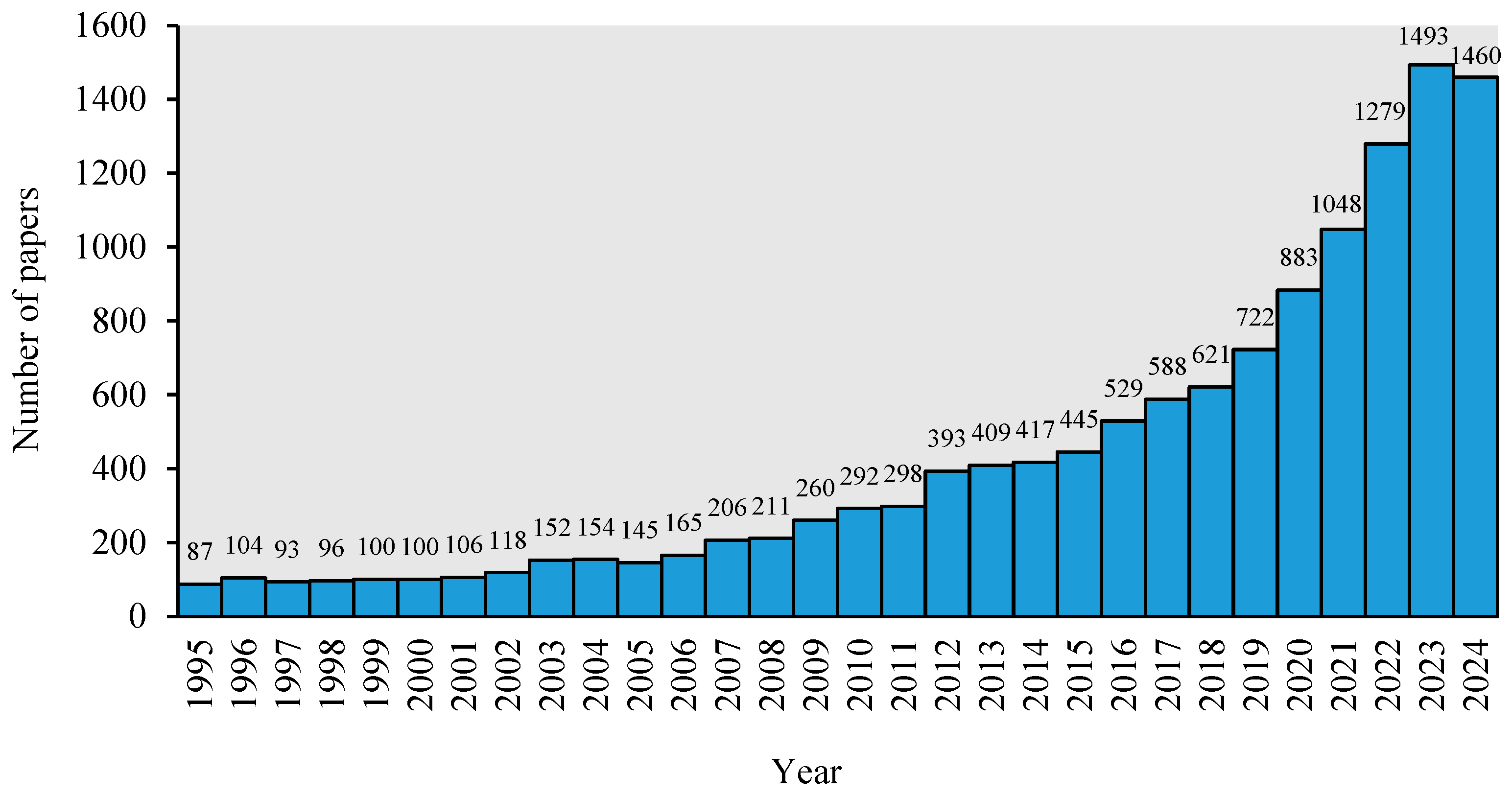
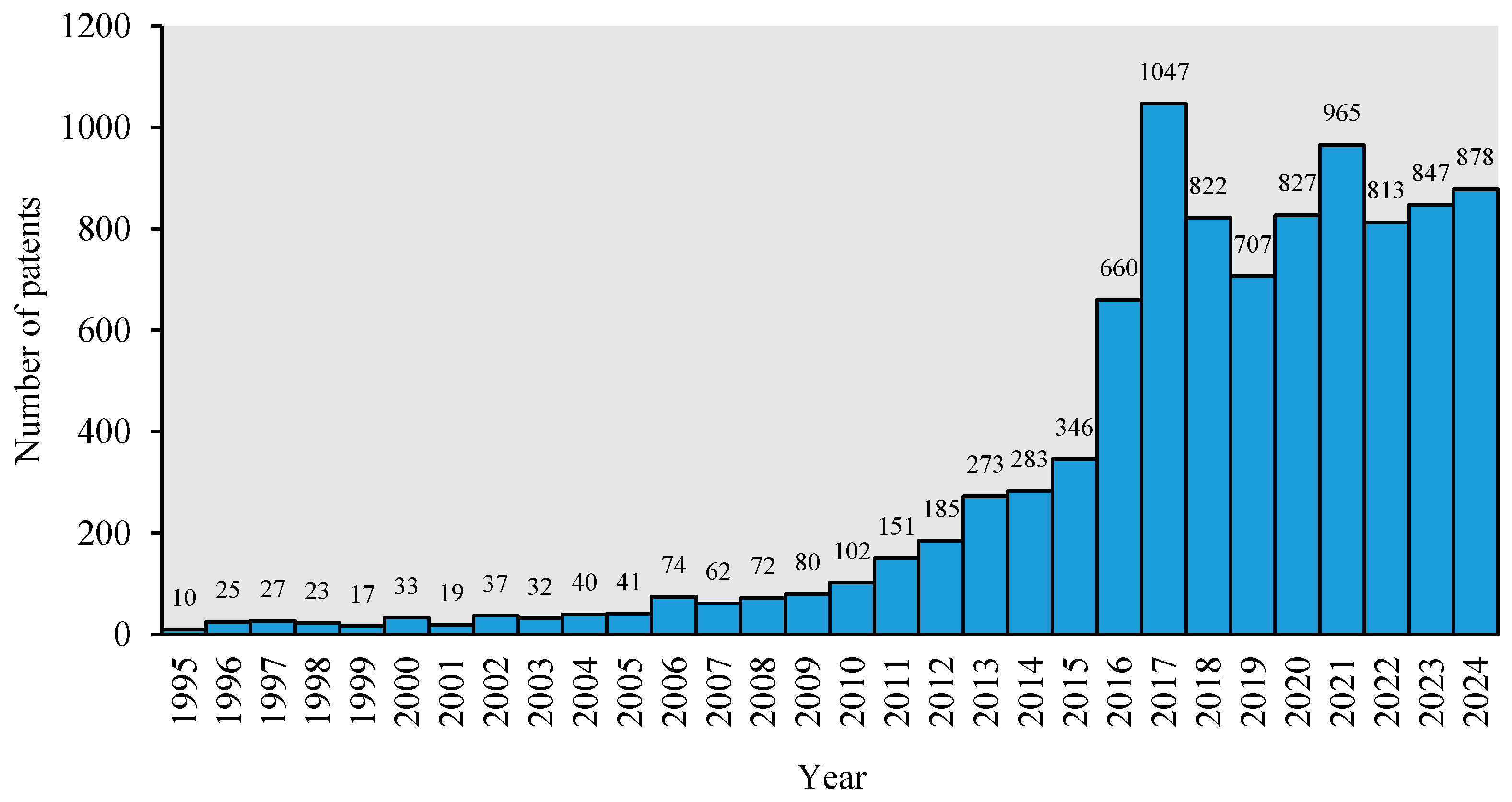
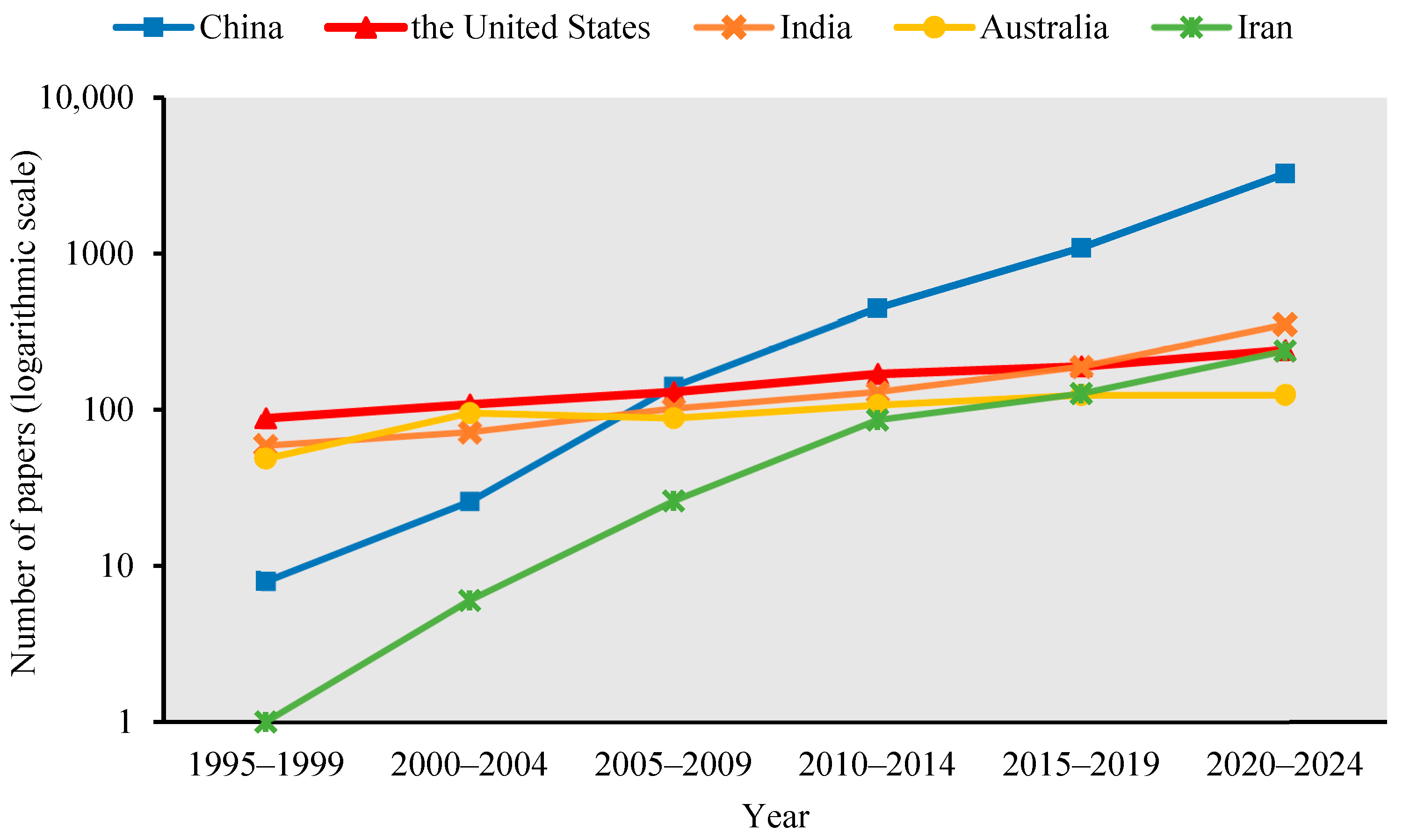
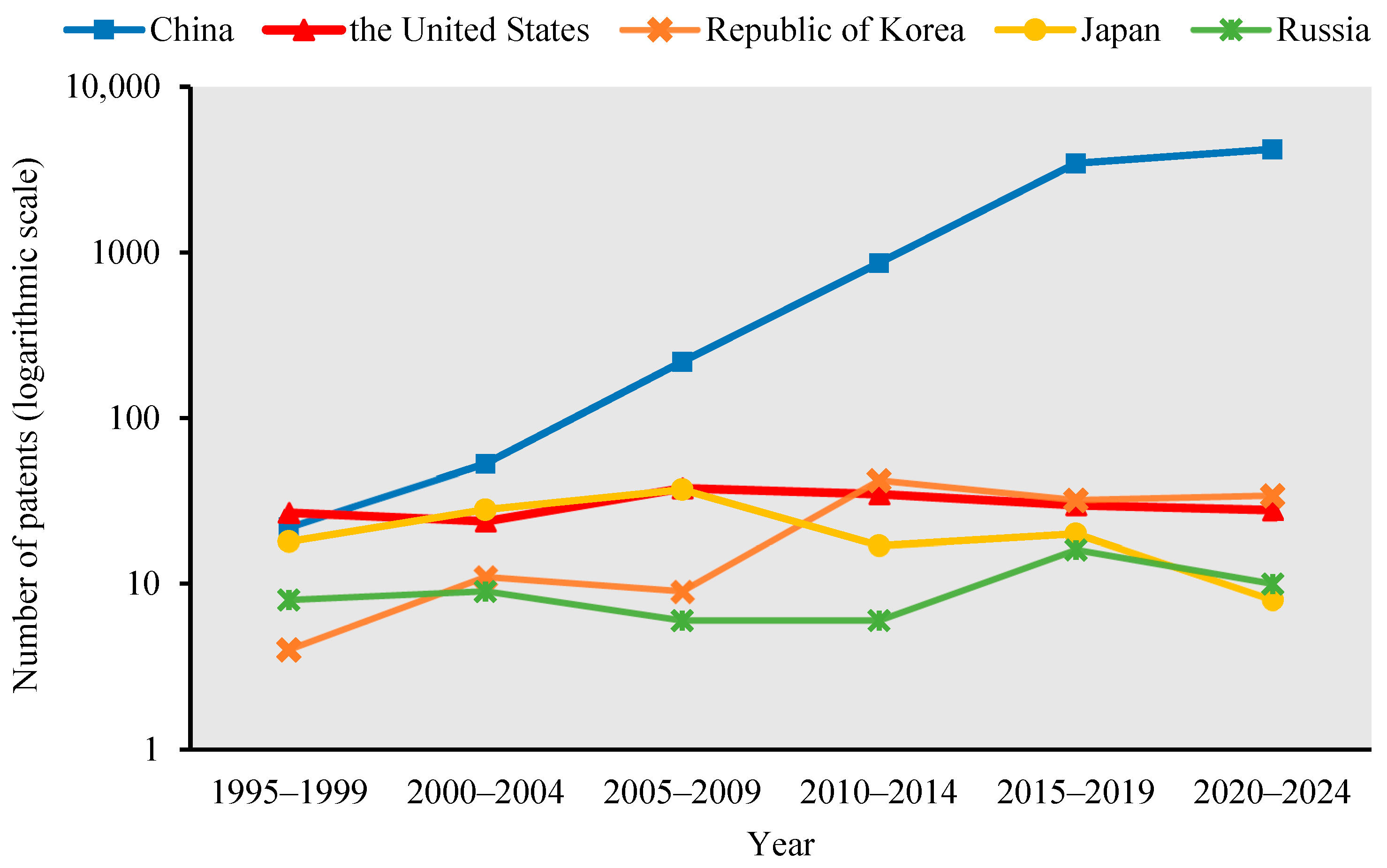

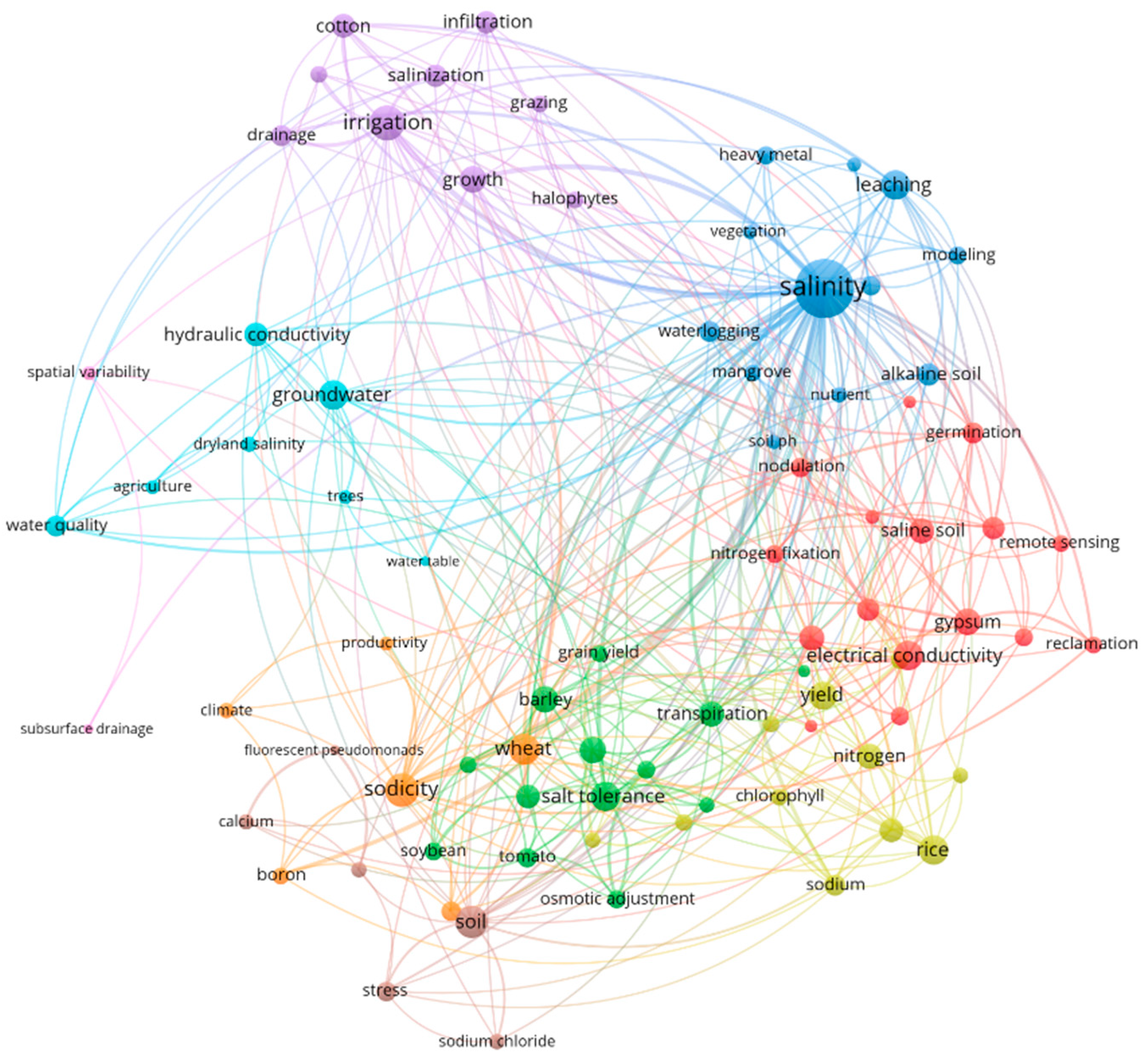
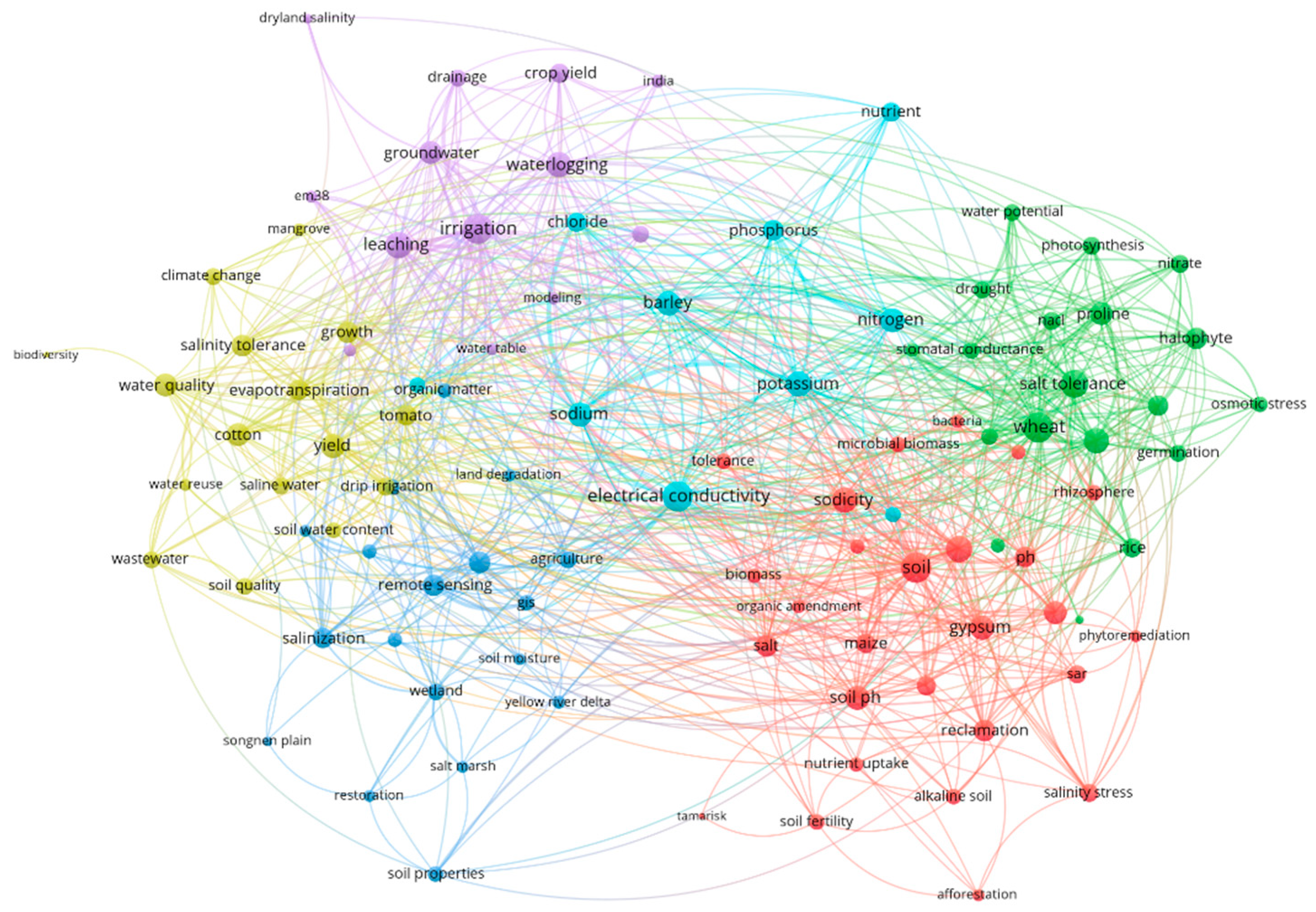
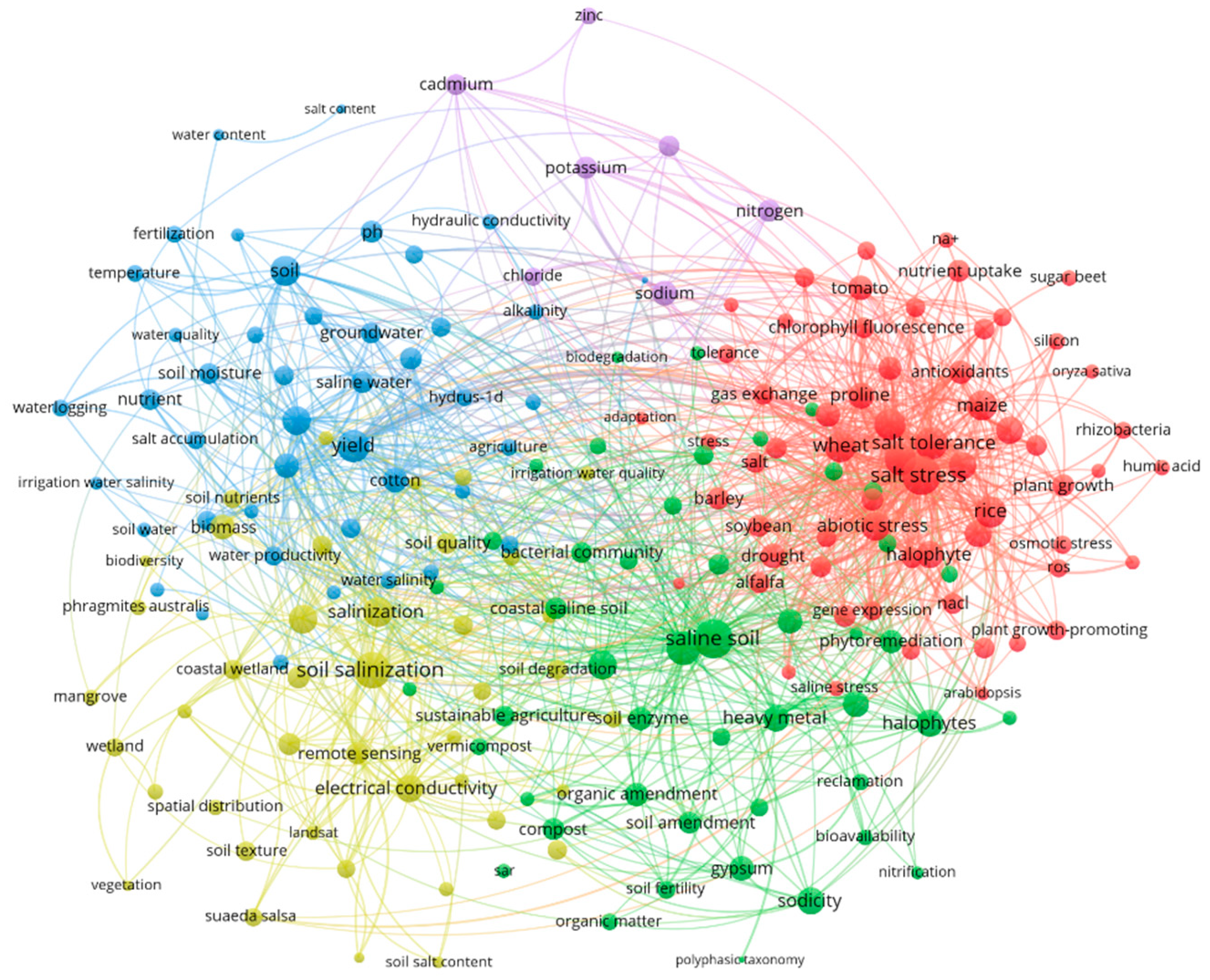
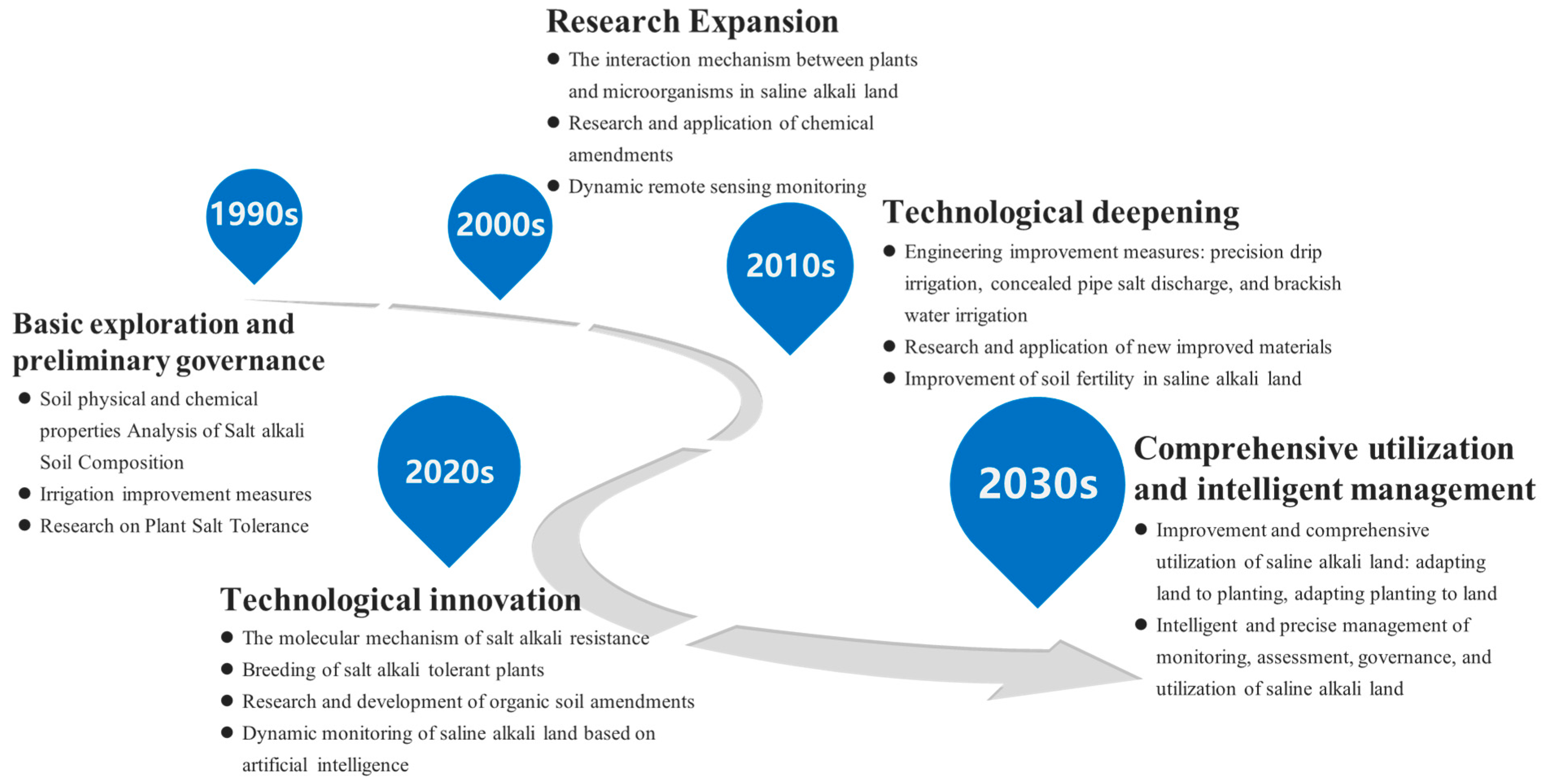
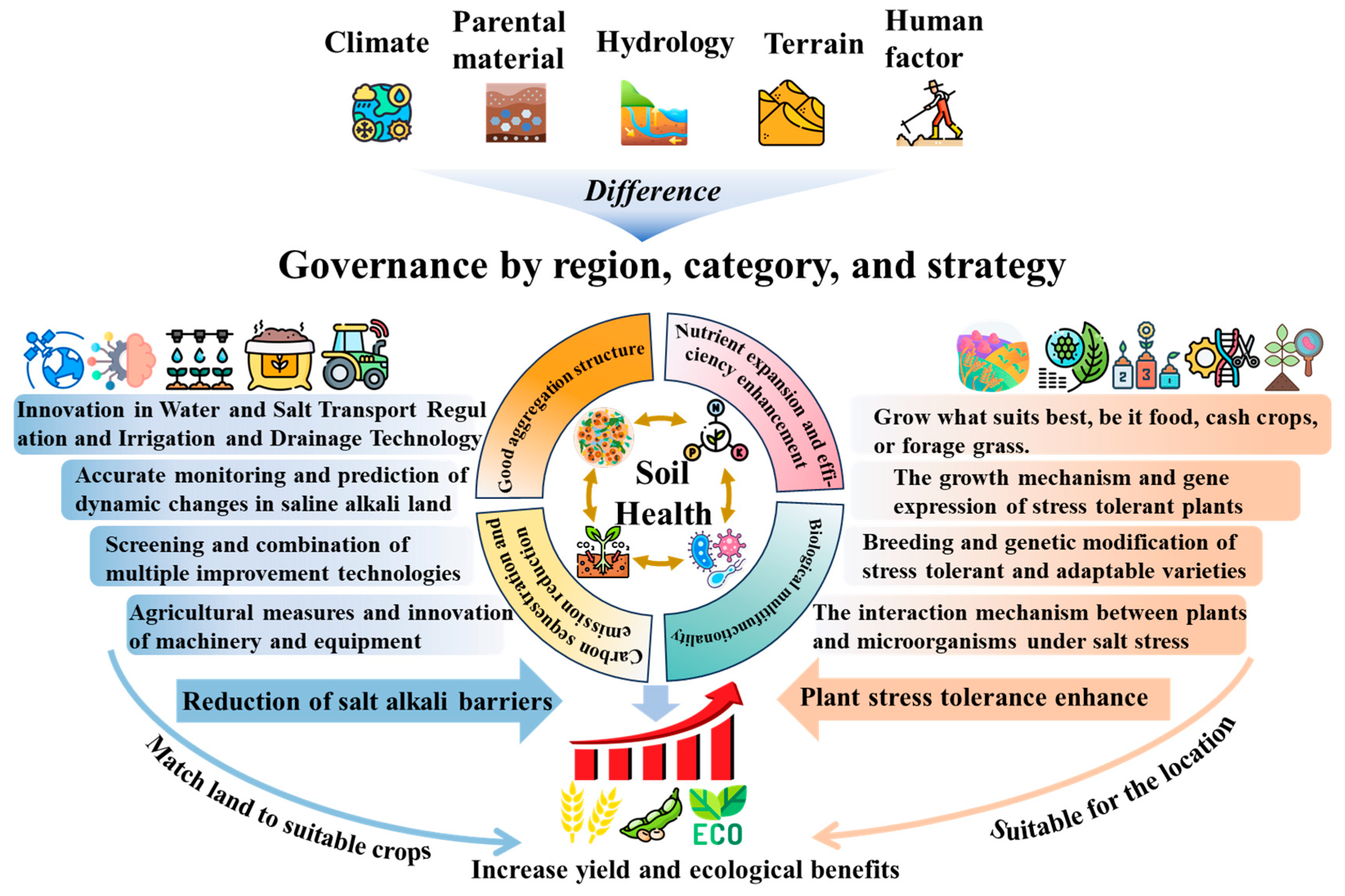
| Ranking | Distribution of Papers by Country/Region | Distribution of Patents by Country/Region | ||||
|---|---|---|---|---|---|---|
| Country/Region | Number of Papers | Percentage of Papers/% | Country/Region | Number of Patents | Proportion of Patents/% | |
| 1 | China | 4973 | 38.33 | China | 8809 | 92.75 |
| 2 | The United States | 934 | 7.20 | The United States | 182 | 1.92 |
| 3 | India | 904 | 6.97 | Republic of Korea | 132 | 1.39 |
| 4 | Australia | 592 | 4.56 | Japan | 128 | 1.35 |
| 5 | Iran | 484 | 3.73 | Russia | 55 | 0.58 |
| 6 | Pakistan | 483 | 3.72 | Australia | 35 | 0.37 |
| 7 | Spain | 365 | 2.81 | India | 28 | 0.29 |
| 8 | Egypt | 326 | 2.51 | Germany | 27 | 0.28 |
| 9 | Brazil | 288 | 2.22 | Spain | 17 | 0.18 |
| 10 | Italy | 257 | 1.98 | Uzbekistan | 9 | 0.09 |
| Ranking | Country/Region | Total Citation Frequency | Average Citation Frequency Per Paper | Number of High-Impact Papers | Proportion of High-Impact Papers in Total Publications |
|---|---|---|---|---|---|
| 1 | China | 106,016 | 21.32 | 416 | 8.37 |
| 2 | The United States | 31,716 | 33.96 | 149 | 15.95 |
| 3 | India | 22,526 | 24.92 | 99 | 10.95 |
| 4 | Australia | 19,626 | 33.15 | 93 | 15.71 |
| 5 | Spain | 10,784 | 29.55 | 38 | 10.41 |
| 6 | Pakistan | 10,096 | 20.9 | 46 | 9.52 |
| 7 | Iran | 9251 | 19.11 | 37 | 7.64 |
| 8 | Egypt | 9006 | 27.63 | 36 | 11.04 |
| 9 | Italy | 7835 | 30.49 | 34 | 13.23 |
| 10 | Canada | 7117 | 38.47 | 23 | 12.43 |
| Ranking | Country/Region | Number of High-Value Patents | Proportion of High-Value Patents in Total Patents | Proportion of High-Value Patents in Total National Patents/ % |
|---|---|---|---|---|
| 1 | China | 220 | 49.22 | 2.50 |
| 2 | The United States | 83 | 18.57 | 45.60 |
| 3 | Japan | 61 | 13.65 | 47.66 |
| 4 | Republic of Korea | 23 | 5.15 | 17.42 |
| 5 | Germany | 19 | 4.25 | 70.37 |
| 6 | Australia | 12 | 2.68 | 34.29 |
| 7 | India | 7 | 1.57 | 25.00 |
| 8 | Spain | 7 | 1.57 | 41.18 |
| 9 | Belgium | 6 | 1.34 | 85.71 |
| 10 | The United Kingdom | 3 | 0.67 | 37.50 |
| Cluster | Research Topic | Representative Keywords |
|---|---|---|
| 1 | Growth mechanism and gene expression of crops/plants under salt stress | salt stress, gene expression, salinity tolerance, proteomics, plant growth, photosynthesis, osmoregulation, antioxidant, seed yield, wheat, zea mays, rice |
| 2 | Interaction mechanism between plants and microorganisms in saline–alkali land and the application of soil amendments | halophytes, phytoremediation, microbial diversity, bacterial diversity, arbuscular mycorrhizal fungi, enzyme activity, organic fertilizer, soil amendment, biochar |
| 3 | Remote sensing of saline–alkali land changes and environmental responses to soil salinization | soil salinization, climate change, ecological restoration, carbon sequestration, coastal wetland, mangrove, salt marsh, Yellow River Delta, Songnen plain, digital soil mapping, GIS, Landsat, remote sensing |
| 4 | Techniques and mechanisms in saline–alkali land irrigation, drainage, and soil water–salt dynamics | drip irrigation, wastewater, irrigation, groundwater, soil water content, water use efficiency, water quality, nitrate, salt accumulation |
| 5 | Nutrient status and improvement of saline–alkali soil | micronutrients, iron, sodium, potassium, calcium, nitrogen, phosphorus |
Disclaimer/Publisher’s Note: The statements, opinions and data contained in all publications are solely those of the individual author(s) and contributor(s) and not of MDPI and/or the editor(s). MDPI and/or the editor(s) disclaim responsibility for any injury to people or property resulting from any ideas, methods, instructions or products referred to in the content. |
© 2025 by the authors. Licensee MDPI, Basel, Switzerland. This article is an open access article distributed under the terms and conditions of the Creative Commons Attribution (CC BY) license (https://creativecommons.org/licenses/by/4.0/).
Share and Cite
Huang, J.; Shang, Y.; Chen, Y.; Xu, L.; Yang, Y.; Zhao, X. Analysis of Research Trends and Comprehensive Utilization Solutions for Saline–Alkali Land. Sustainability 2025, 17, 5202. https://doi.org/10.3390/su17115202
Huang J, Shang Y, Chen Y, Xu L, Yang Y, Zhao X. Analysis of Research Trends and Comprehensive Utilization Solutions for Saline–Alkali Land. Sustainability. 2025; 17(11):5202. https://doi.org/10.3390/su17115202
Chicago/Turabian StyleHuang, Jingyan, Yehua Shang, Yuqi Chen, Lingying Xu, Yanping Yang, and Xu Zhao. 2025. "Analysis of Research Trends and Comprehensive Utilization Solutions for Saline–Alkali Land" Sustainability 17, no. 11: 5202. https://doi.org/10.3390/su17115202
APA StyleHuang, J., Shang, Y., Chen, Y., Xu, L., Yang, Y., & Zhao, X. (2025). Analysis of Research Trends and Comprehensive Utilization Solutions for Saline–Alkali Land. Sustainability, 17(11), 5202. https://doi.org/10.3390/su17115202






